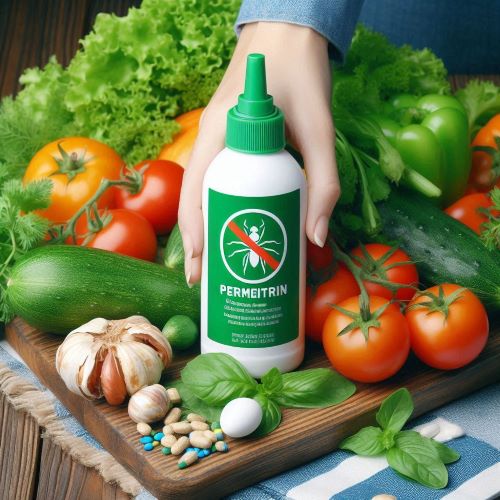Permethrin is a widely used pesticide recognized for its effectiveness in controlling a variety of pests. It plays a crucial role in agriculture, particularly in the cultivation of vegetables. Despite its benefits in pest management, Permethrin poses certain risks to human health and the environment. This article delves into the details of Permethrin, including its description, usage, risks, and regulatory status in India and globally.
What is Permethrin?
Permethrin is a synthetic chemical belonging to the pyrethroid family, designed to mimic the natural insecticidal properties of pyrethrins derived from chrysanthemum flowers. It is widely used due to its potency and relatively low toxicity to mammals when used correctly. (Source)
Also, read: All You Need to Know About Malathion, A Common Pesticide Used in Vegetables
Description and Usage
Description: It is available in various formulations, including liquids, powders, dusts, and aerosols. It is used in agricultural, residential, and public health settings for controlling a wide range of pests such as mosquitoes, ticks, fleas, and agricultural insects. (Source)
Usage:
- Vegetables: It is extensively used on crops like tomatoes, peppers, and leafy greens to manage pests such as aphids, caterpillars, and beetles.
- Fruits: It is applied to fruit crops including apples, pears, and berries to control moths, fruit flies, and other insects.
- Field Crops: Used in the cultivation of crops like cotton, corn, and soybeans.
- Public Health: Utilized in mosquito control programs and for treating lice and scabies in humans. (Source)
Risks to Human Health and Environment
Health Risks:
- Acute Toxicity: Short-term exposure to it can cause skin irritation, eye irritation, and respiratory issues. Ingesting large amounts can lead to nausea, vomiting, and central nervous system effects such as seizures.
- Chronic Exposure: Long-term exposure may result in neurological problems, liver damage, and hormonal disruptions. Studies on animals suggest that high doses over extended periods can lead to carcinogenic effects.
- Sensitivity: Some individuals may be more sensitive to Permethrin, experiencing allergic reactions or exacerbation of asthma symptoms. (Source)
Environmental Risks:
- Water Contamination: It is highly toxic to aquatic life, including fish and invertebrates. Runoff from agricultural fields can contaminate water bodies, leading to significant ecological impacts.
- Non-Target Species: While it is effective against pests, it can also harm beneficial insects such as bees and butterflies, disrupting local ecosystems.
- Persistence: It can persist in the environment, particularly in soil and water, leading to prolonged exposure risks for non-target organisms. (Source)
Use of Permethrin in India
States and Crops: It is used across various Indian states, with significant application in Punjab, Haryana, Maharashtra, and Karnataka. It is prevalent in the cultivation of vegetables like tomatoes, peppers, and leafy greens.
Regulatory Status in India
In India, Permethrin is regulated by the Central Insecticides Board and Registration Committee (CIBRC). It is not banned but is subject to guidelines to ensure its safe use. Farmers are advised to follow recommended application rates and safety protocols to minimize risks to human health and the environment.
Global Status of Permethrin
United States: The Environmental Protection Agency (EPA) regulates Permethrin under the Federal Insecticide, Fungicide, and Rodenticide Act (FIFRA). It is approved for use, with specific restrictions to ensure safe application and reduce risks.
European Union: Permethrin is authorized for use within the EU, but its application is tightly controlled to protect human health and the environment.
Other Countries:
- Australia: Permethrin is registered for use, with strict guidelines to ensure safe application.
- Canada: The Pest Management Regulatory Agency (PMRA) oversees the use of Permethrin, ensuring it meets safety standards.
- Brazil: Permethrin is approved for use, but regulatory measures are in place to mitigate health and environmental risks.
Also, watch web stories: What is the Best Time to Eat Dry Fruits?
FAQs
1. Is Permethrin safe for household use?
- Yes, Permethrin is available for household use in specific formulations, such as lice shampoos and insect repellents. It should be used according to the manufacturer’s instructions.
2. How can Permethrin exposure occur?
- Exposure can occur through skin contact, inhalation of aerosols, and ingestion of contaminated food or water.
3. What are the symptoms of Permethrin poisoning?
- Symptoms include skin and eye irritation, respiratory issues, nausea, vomiting, and in severe cases, seizures.
4. Are there safer alternatives to Permethrin?
- Integrated pest management (IPM) strategies and biological controls can offer effective pest control with reduced health and environmental risks.
5. Why is Permethrin controversial?
- Permethrin is controversial due to its potential health risks, environmental impact, and the possibility of developing resistance in pests.





